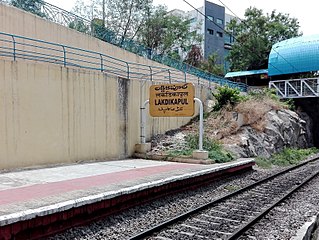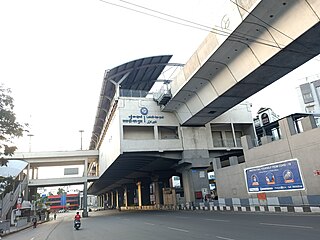
Secunderabad is a twin city of Hyderabad and one of the six zones of the Greater Hyderabad Municipal Corporation (GHMC) in the Indian state of Telangana. It is the headquarters of the South Central Railway zone. Named after the Mir Akbar Ali Khan Sikander Jah, Asaf Jah III, Nizam of the Asaf Jahi dynasty, Secunderabad was established in 1806 as a British cantonment. Although both the cities are together referred to as the twin cities, Hyderabad and Secunderabad have different histories and cultures, with Secunderabad having developed directly under British rule until 1948, and Hyderabad as the capital of the Nizams' princely state of Hyderabad. Since 1956, the city has housed the Rashtrapati Nilayam, the winter office of the president of India. It is also the headquarters of the 54th Infantry Division of the Indian Army.
Langar Houz is a suburb of Hyderabad, near Golconda, in the Indian state of Telangana. It is a major commercial centre for the city's cantonment area. Langar Houz was once considered to be the gateway to the city and Golkonda Palace.

Birla Mandir is a Hindu temple built on a 280 feet (85 m) high hillock called Naubath Pahad on a 13 acres (53,000 m2) plot in Hyderabad, Telangana, India. The construction took ten years and was opened in 1976 by Swami Ranganathananda of Ramakrishna Mission. The temple was constructed by the Birla Foundation, which has also constructed several similar temples across India, all known as Birla Mandir.

Shamirpet Lake also known as Pelle Cheruvuis an artificial lake near Hyderabad, India, it is about 24 kilometres (15 mi) north of Secunderabad.

Khairatabad is a neigbbourhood in Hyderabad, Telangana, India. It is a mandal in the Secunderabad Revenue division of Hyderabad District. This is a Zone in the Greater Hyderabad Municipal Corporation. There are five circles in this zone namely Mehdipatnam (12), Karwan (13), Goshamahal (14), Khairatabad (17) and Jubilee Hills (18). There are four wards under this Khairatabad circle, they are Khairtabad (91), Somajiguda (97), Ameerpet (98) and Sanathnagar (100).

Hyderabad is located in central Telangana and is spread over an area of 2,500 km2. The city lies in the Deccan Plateau and rises to an average height of 536 m above the sea level. The city lies at 17.366° N latitude and 78.476° E longitude.

Lakdi ka pul is a neighbourhood in Hyderabad, India.

Purana Pul, built in 1578 AD is a bridge over river Musi in Hyderabad, Telangana, India. It is the first bridge ever constructed in Hyderabad and among the oldest in South India.
Toli chowki is a neighbourhood in Hyderabad, Telangana, India. The name Tolichowki comes from the Urdu word 'Toli', meaning 'troupe', and 'Chowki', meaning 'post'. It is close to the IT corridor like Gachibowli, Madhapur, Manikonda and Kondapur, hence making it a preferred residential for people working in the IT industry. The real estate sector has received a boost due to its proximity to high-end technology firms. Tolichowki has also had a boost in the restaurant and fast food industry. It is known to attract many customers from all around due to having multi-cuisine meals all around the area. There has been an emergence of Arab cuisine in the area due to Middle Eastern people's moving in the area for medical or academic purposes. This in return has improved Tolichowki's market value for foreigners

Dar-ul-Shifa is a neighbourhood in the Old City of Hyderabad, India, named after the 16th-century hospital it once housed. The location was founded in AD 1591, more than 400 years ago, by Mohammed Quli Qutub Shah, the founder of Hyderabad city. Today it houses a large population of Shia Muslims and comes alive on the days of Muharram and Shia festivals. Most of the households have family members settled abroad, whose remittances increase the quality of life.

Lakdikapul railway station is a railway station located in Hyderabad, Telangana, India. Localities like Red Hills, Public Gardens and Masab Tank are accessible from this station.

Lumbini Park, officially T. Anjaiah Lumbini Park, is a small public, urban park of 3 hectares adjacent to Hussain Sagar in Hyderabad, India. Since it is located in the centre of the city and is in close proximity to other tourist attractions, such as Birla Mandir and Necklace Road, it attracts many visitors throughout the year. Boating is one of the best attractions and people go to the Buddha idol placed in the middle of the Tank Band in the boats. Constructed in 1994, the park is named after the former Chief Minister of Andhra Pradesh T. Anjaiah. The park is maintained by the Buddha Purnima Project Authority of the Government of Telangana. In 2007, it was one of the targets of the 25 August 2007 Hyderabad bombings that killed 44 people.

Once upon a time, Hyderabad was known as City of Lakes. Some of these lakes are natural and various are manmade bodies. As per various sources only a few decades back, Hyderabad had a large number of water bodies such as lakes, reservoirs, rivers, streams, aquaculture ponds, tanks etc.. As per the data from National Remote Sensing Centre, between 1979 and 2023 there has been a reduction of 61% in city’s lake area. Area occupied by 56 lakes were examined and it was found that the total area of these lakes has shrunk from 40.35 km2 (15.58 sq mi) 16 km2 (6.2 sq mi). Most of these lakes have totally disappeared and the surface area of most of the surviving lakes have shrunken and turned to tiny ponds and cesspool. Some of the lakes which have totally disappeared are Tigal Kunta, Somajiguda Tank, Mir Jumla tank, Pahar Tigal Kunta, Kunta Bhawani Das, Nawab Saheb Kunta, Afzalsagar, Nallakunta, Masab Tank etc. Hussainsagar Lake, Kunta Mallaiyapalli have shrunk drastically. Out of thousands of water bodies those were existing in 1970s in various sizes in and around Hyderabad, today only about 70 to 500 of them have survived. Most of them have disappeared due to encroachment or have been illegally drained for real estate projects by private or government agencies. The existing lakes have been used to dump garbage and sewage water. Most of these lakes and tanks were built during the regime of Qutub Shah in 16th and 17th century and later by Nizams as a source of drinking water for the residents of Hyderabad. The area of Hussain Sagar, which is the largest lake in Hyderabad shrunk by more than 40% i.e. from 550 ha to 349 ha in just 30 years. This lake was built in 1575 AD and since 1930 is not being used as a source for drinking water.

Hussain Sagar is a heart-shaped lake in Hyderabad, Telangana, India, built by Ibrahim Quli Qutb Shah in 1562. It is spread across an area of 5.7 square kilometres (2.2 sq mi) and is fed by the River Musi. A large monolithic statue of the Gautama Buddha, erected in 1992, stands on Gibraltar Rock in the middle of the lake. The lake separates the city centre of Hyderabad from the neighbourhood of Secunderabad. The maximum depth of the lake is 32 feet (9.8 m).

The Old City of Hyderabad is a walled city of Hyderabad, Telangana, India, located on the banks of the Musi River built by Qutb Shahi sultan Muhammed Quli Qutb Shah in 1591 AD. There used to be a wall surrounding the Old City, most of which is destroyed. Mubariz Khan, the Mughal governor of Deccan Subah, had fortified the city in 1712 and was completed by Nizam of Hyderabad.
Mallepally is located near Asifnagar in Hyderabad, India. It is a locality in Hyderabad District and one of the old suburbs that have existed for a long while now. It is one of the oldest localities to exist in the history of Hyderabad during the time of Nizams.
The Hyderabad Inner Ring Road is a 50 kilometer city arterial road in Hyderabad, Telangana. It was built to decongest city roads and give way for trucks and other commercial vehicles.

Lakdi-ka-pul is a metro station on the Red Line of the Hyderabad Metro in India. This station was opened to public on 2017. It is located at Lakdi ka pul near to Lakdikapul railway station, Ravindra Bharathi, HP Petrol pump, Telephone Bhavan, Collector's Office, CID Office and Global Hospitals.















